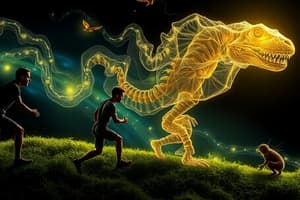Podcast
Questions and Answers
What is chemotaxis and phototaxis?
What is chemotaxis and phototaxis?
Chemotaxis is the movement of organisms toward or away from chemicals, while phototaxis is the movement toward or away from light.
Describe the process of DNA duplication and cell division in single-celled organisms.
Describe the process of DNA duplication and cell division in single-celled organisms.
Single-celled organisms duplicate their DNA first, then the cell divides to form two new cells.
Explain the concept of homeostasis in organisms.
Explain the concept of homeostasis in organisms.
Homeostasis is the ability of an organism to maintain constant internal conditions.
What are macromolecules and how are they formed?
What are macromolecules and how are they formed?
What are the four elements common to all living organisms?
What are the four elements common to all living organisms?
What are some characteristics of living organisms according to the text?
What are some characteristics of living organisms according to the text?
When did humans start to resemble how they do today?
When did humans start to resemble how they do today?
Define Biology according to the text.
Define Biology according to the text.
Which field of study focuses on animals?
Which field of study focuses on animals?
What is Microbiology according to the text?
What is Microbiology according to the text?
Explain the process of chemotaxis and provide an example of an organism that exhibits this behavior.
Explain the process of chemotaxis and provide an example of an organism that exhibits this behavior.
How do plants acquire energy, and what do they convert it into?
How do plants acquire energy, and what do they convert it into?
What is the role of organelles in a cell, and provide examples of two organelles.
What is the role of organelles in a cell, and provide examples of two organelles.
Define macromolecules and explain how they are different from regular molecules.
Define macromolecules and explain how they are different from regular molecules.
Name the four elements common to all living organisms and explain their significance.
Name the four elements common to all living organisms and explain their significance.
Flashcards are hidden until you start studying




